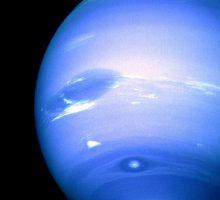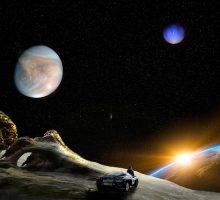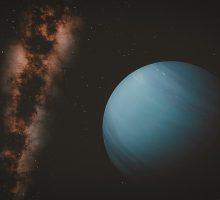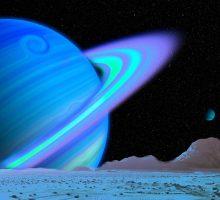- Exploring the Mysterious World of Neptune
- Neptune’s Atmosphere
- The Great Dark Spot
- Neptune’s Rings
- Neptune’s Moons
- Neptune’s Magnetic Field
- Neptune’s Interior
- Exploring Neptune
- Neptune’s Importance in Astronomy
- Neptune’s Potential for Life
- Neptune’s Relationship with Uranus
Exploring the Mysterious World of Neptune
Neptune, the eighth and farthest known planet from the sun in our solar system, is a gaseous giant with a striking blue hue. Discovered in 1846, Neptune is the fourth-largest planet by diameter and the third-largest by mass. Despite being the fourth most massive planet, it has a lower density than any of the giant planets. Neptune is about 17 times the mass of Earth and is almost four times the size of Earth. In this blog post, we will explore the mysterious world of Neptune and learn about its fascinating features.
Neptune’s Atmosphere
Neptune’s atmosphere is composed mainly of hydrogen and helium, with traces of methane, ammonia, and water vapor. The methane in Neptune’s upper atmosphere gives the planet its blue color. Scientists believe that the methane absorbs red light, and reflects blue light back into space. Neptune’s atmosphere also has the fastest winds in the solar system, with gusts reaching up to 1,200 miles per hour.
The Great Dark Spot
One of the most intriguing features of Neptune is the Great Dark Spot. It is a massive, spinning storm in Neptune’s southern hemisphere, similar to Jupiter’s Great Red Spot. The Great Dark Spot was first observed in 1989 by the Voyager 2 spacecraft, and it was found to be about the size of Earth. However, in 1994, when the Hubble Space Telescope observed Neptune, the Great Dark Spot had disappeared. Scientists believe that the spot may have been a temporary phenomenon, caused by the planet’s atmosphere.
Neptune’s Rings
Neptune has a system of rings, similar to Saturn’s but much fainter. The rings are made up of billions of particles of ice and dust, ranging in size from a few microns to several meters. There are five main rings around Neptune, named Galle, Le Verrier, Lassell, Arago, and Adams. The rings are thought to be relatively young, perhaps only a few hundred million years old, which is young in astronomical terms. The particles in the rings are believed to have come from one or more of Neptune’s moons, which were disrupted by impacts from comets or asteroids.
Neptune’s Moons
Neptune has 14 known moons, with the largest being Triton. Triton is the seventh-largest moon in the solar system, and it is the only large moon in the solar system that orbits in the opposite direction of its planet’s rotation. Triton is also one of the coldest objects in the solar system, with temperatures around minus 390 degrees Fahrenheit. It has a thin atmosphere composed mainly of nitrogen, with traces of methane and carbon monoxide. Triton’s surface is covered in a mixture of nitrogen, methane, and carbon dioxide ice.
Other notable moons of Neptune include Nereid, Proteus, and Larissa. Nereid is an irregularly shaped moon that has a highly elliptical orbit around Neptune. Proteus is the second-largest moon of Neptune and is believed to be a heavily cratered, icy body. Larissa is a small, irregularly shaped moon that was discovered in 1981 by Voyager 2.
Neptune’s Magnetic Field
Neptune has a strong magnetic field that is tilted at an angle of about 47 degrees to its rotation axis. The magnetic field is believed to be generated by convection currents in the planet’s mantle. The magnetic field is about 27 times more powerful than Earth’s magnetic field and is strong enough to trap charged particles from the solar wind and create auroras.
Neptune’s Interior
Like other gas giants, Neptune does not have a solid surface, and its interior is divided into layers. The outermost layer is the atmosphere, which is composed mainly of hydrogen and helium. Below the atmosphere is a layer of liquid hydrogen, which is believed to be electrically conducting. Deeper still is a layer of ice and rock, which is thought to surround a small, rocky core. The exact composition and size of Neptune’s core are still unknown, but scientists believe that it is about the size of Earth and composed mainly of silicates and metals.
Exploring Neptune
Only one spacecraft has visited Neptune: the Voyager 2 spacecraft in 1989. During its flyby, Voyager 2 was able to capture images and data of Neptune and its moons, providing valuable insights into the planet’s composition and structure. The spacecraft was also able to study the planet’s magnetic field and the rings and atmosphere of the planet.
In recent years, there have been several proposals for future missions to Neptune, including an orbiter and a lander. These missions would allow scientists to study Neptune’s interior, atmosphere, and moons in greater detail.
Neptune’s Importance in Astronomy
Neptune plays an important role in the study of astronomy, as it provides valuable insights into the formation and evolution of our solar system. The giant planets, including Neptune, are thought to have formed from the gas and dust left over after the formation of the sun. By studying the composition and structure of Neptune and other gas giants, scientists can better understand the conditions that existed during the early stages of our solar system.
Neptune’s atmosphere is also of great interest to scientists, as it provides an example of how atmospheres can be affected by the planet’s environment. The fast winds in Neptune’s atmosphere, for example, are thought to be driven by the planet’s rotation and the heat generated by its interior. By studying Neptune’s atmosphere, scientists can gain a better understanding of atmospheric dynamics and the conditions that can lead to extreme weather patterns.
Neptune’s moons are also important objects of study, as they can provide insights into the formation and evolution of the giant planets. Triton, in particular, is of interest to scientists, as its retrograde orbit suggests that it was captured by Neptune from the Kuiper Belt, a region of icy objects beyond the orbit of Neptune. By studying Triton and other moons, scientists can gain a better understanding of the dynamics of the outer solar system and the processes that led to the formation of the planets.
In addition to its scientific importance, Neptune is also a fascinating object of study due to its beauty and mystery. The planet’s blue color and dynamic atmosphere have captured the imagination of scientists and the public alike, and have inspired countless works of art and literature.
Neptune’s Potential for Life
While it is highly unlikely that life exists on Neptune itself, the planet and its moons do offer some interesting possibilities for the existence of extraterrestrial life.
One of Neptune’s moons, Triton, is believed to have a subsurface ocean that may contain liquid water. Liquid water is a key ingredient for life as we know it, and the presence of a subsurface ocean on Triton raises the possibility that microbial life could exist in its depths.
Other moons of Neptune, such as Nereid and Proteus, are also thought to have subsurface oceans, which could potentially harbor life. In addition, the Kuiper Belt, the region of icy objects beyond the orbit of Neptune, is believed to contain many objects that may have subsurface oceans.
While the conditions on Neptune itself are not conducive to the existence of life, the presence of subsurface oceans on its moons and in the Kuiper Belt raises the possibility that life may exist elsewhere in our solar system.
Neptune’s Relationship with Uranus
Neptune has an interesting relationship with its neighboring planet, Uranus. The two planets are often considered “sister” planets, as they are both ice giants and have similar compositions and atmospheres. However, Neptune is slightly larger and more massive than Uranus, and its atmosphere is more dynamic.
The two planets also have an interesting orbital relationship. While most planets in our solar system have orbits that are nearly circular, the orbits of Neptune and Uranus are highly elliptical. This means that the two planets periodically pass close to each other as they orbit the sun. When this happens, the gravitational pull of one planet on the other can cause significant changes in the other planet’s orbit.
In fact, it is believed that Neptune’s gravitational pull may have been responsible for the unusual tilt of Uranus’ axis. Uranus is unique among the planets in our solar system in that its axis is tilted at an angle of nearly 98 degrees, meaning that its poles are almost in the plane of its orbit. It is thought that Neptune’s gravity may have caused this unusual tilt during a close pass by the two planets early in the history of the solar system.











